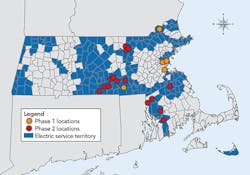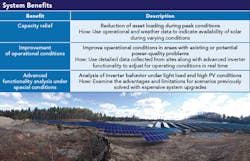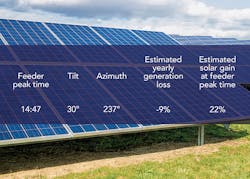National Grid Embraces New Energy Solutions
People are talking and rumors are flying about what will be the next big thing in the energy sector. In his book The Third Industrial Revolution, author Jeremy Rifkin explores the concept of how the Internet and renewable energy are merging to usher in a new age of innovation. Many of Rifkin’s concepts are already coming to fruition, such as large-scale adoption of renewables and faster communication methods to better monitor and control the grid.
Just 10 years ago, consumers did not think a camera on a cell phone was necessary or practical. Today, it is difficult to find anyone still using a stand-alone camera. This example goes to show how fast perceptions and standard practices can change when a more efficient and economical solution is presented.
Those who have been in the electric utility industry long enough probably remember a time in the not-so-distant past when power only flowed in one direction. It was a simpler time, an easier time and, some would say, a perfect time in history. Whether the electric utility likes it or not, those days are long gone. Because of the vast increase in distributed generation (DG) on the existing systems, utilities of the 21st century are forced to deal with power flowing in all directions.
What once was a beautiful blue-sky day for system operators is now a day full of added pressures, resulting in the complex coordination of thousands of moving parts that must flow as one cohesive unit to match generation to loads and maintain a stable voltage and frequency. With the large influx of distributed energy resources (DERs), utilities have to think outside the box when interconnecting these new resources to their systems. Increased levels of DER penetration have created numerous distribution issues, including voltage, protection and islanding concerns. The utility industry has realized DG is here to stay. The questions are no longer when and how but rather where and how much. National Grid is taking a holistic and imaginative approach by investigating how utilities can make DERs work for them, not against them.
Solar in the Commonwealth
Massachusetts is known for its beautiful fall foliage, picturesque Cape Cod scenery and unpredictable weather patterns. In the words of Mark Twain, “If you don’t like the weather in New England now, just wait a few minutes.” What many do not know is Massachusetts is ranked fifth in the U.S. for solar capacity, according to the Solar Electric Power Association’s “Utility Solar Market Snapshot” report. With more than 22,000 installations, Massachusetts is quickly following the ranks of other large solar players like California and Arizona.
National Grid’s solar story began back in 2009 with its Solar Phase I program, which resulted in the development of 5 MW of utility-owned solar on underused sites and remediated brownfields. Solar Phase I helped to boost renewable energy awareness and create jobs in Massachusetts.
National Grid’s customers demand more of their energy to come from renewable resources and expect their utility to help make it happen. Because of the current procedures, this can be a lengthy process that often comes at a significant cost. National Grid identified this as a deterrent to the growth of renewable DG and looked for innovative solutions to the problem. In 2014, the utility began its second venture into solar with its Solar Phase II initiative. This program focused on the goal to construct up to 20 MW of photovoltaic (PV) generation in targeted locations with advanced inverters and enhanced communications.
By targeting deployment locations of solar generation on its system, National Grid seeks to determine the real systemic value this energy source could provide when used in a planned way. The testing of advanced inverter technology under diverse system conditions also will help National Grid and the industry gain experience and valuable information about the potential this technology can have on the future of solar integration.
Currently, codes and standards commonly used by utilities do not allow DG sites to be equipped with certain advanced functionality without special utility approval. National Grid plans to change this through the information gained from the testing and analysis at its Phase II sites. This will propagate the integration of new technologies into the grid.
By testing, developing and exploring the full capabilities of advanced inverters in diverse system conditions, the utility industry will be better informed and suited to adopt these new technologies. This will translate into improved integration processes with increased benefits for customers and the entire electric system, while maintaining the utility’s safety and reliability standards.
Targeted Locations
Historically, utilities have taken a reactive approach to interconnecting renewables per customer requests, causing, in some instances, unexpected burdens and costly upgrades to the grid. National Grid strived to do something different with Solar Phase II, focusing on installing sites in targeted locations where the overall system benefits could be greater.
Using the solar team’s motto — integrate versus interconnect — National Grid analyzed its Massachusetts service territory, selecting feeders and towns using these main criteria:
•Heavily loaded feeders
•Lightly loaded feeders
•Areas with low PV penetration
•Areas with high PV penetration.
The use of such criteria enabled the development of versatile new solar sites that could evolve to provide valuable technical information and maximum benefits to customers and the grid.
Test Objectives
National Grid wanted the ability to test Solar Phase II sites for multiple use cases:
• Capacity relief and investment deferment. The utility identified heavily loaded feeders and interconnected solar with advanced inverters in close proximity to substations. Feeder peaks were evaluated, and when applicable, the utility adjusted the azimuth angles of those sites to better match solar generation with peak load conditions. The 1-MW site in Shirley, Massachusetts, is an example. By shifting the azimuth from the standard maximum kilowatt production of 180 degrees to 237 degrees, the utility was able to gain an additional 22% of solar at peak, with only a 9% overall yearly generation loss.
•Evaluation of advanced inverter functions under diverse system conditions. Special consideration was given to areas of the system where light load conditions or a high level of solar generation were already present. Concerns when interconnecting customers in areas with the aforementioned characteristics are the potential for nonconventional power flow directions, abnormal voltage conditions and protection-related issues. By installing advanced inverters on these areas, National Grid will be better suited to assess the performance of advanced functionalities, such as power curtailment, voltage regulation and reactive power compensation under particularly adverse circumstances. This will give the utility an opportunity to test the full capabilities of these new systems and their potential limitations.
• Coordination and system optimization. National Grid is evaluating the coordination of resources at a feeder and station level based on specific control strategies. Depending on the conditions of the system (for example, areas suited for voltage regulation purposes), National Grid would like to test schemes such as distributed power curtailment, reactive compensation and voltage profile adjustment. By deploying solar sites on locations with diverse conditions and existing equipment, National Grid will have a better opportunity to test and optimize different strategies and coordination schemes. The implementation of that coordination will require grouping of evices bounded by an electrical location, such as a feeder or a station, to make the monitoring and control logic viable.
•Reduction of integration costs. National Grid will introduce the testing of additional schemes and products that have the potential to reduce integration costs for future customers. The use of solar sites, under the full operational control of the utility, will enable National Grid to test and assess the performance of schemes that otherwise would be practically impossible to analyze under real conditions. The incorporation of battery storage, a dynamic power curtailment scheme and a communications solution for anti-islanding protection will allow National Grid engineers an opportunity to verify and evaluate these technologies’ reliability and efficacy on replacing some of the costlier existing interconnecting solutions.
Projected Benefits
Solar Phase II program benefits will originate with the customer. National Grid believes, through the Phase II projects, its customers will see greater reliability, enhanced system efficiencies and lower interconnection costs, as well as boosted energy awareness, community outreach and collaboration with local schools and universities for renewable curriculum.
Collaboration with local schools and universities will facilitate extensive research regarding the benefits and challenges associated with distributed renewable generation, leading to a less expensive, more efficient and expedited way to permit and install solar generation facilities for customers.
System benefits include capacity relief, improvement of operational conditions and advanced functionality analysis under special conditions, reducing integration costs while safely and reliably increasing levels of PV penetration. National Grid also hopes to produce information about the value of using advanced technology solar installations as a planning tool, in addition to providing detailed information on the behavior of advanced inverters’ functionality under different operational conditions in Massachusetts.
Unique Locations, Unique Challenges
Building the Phase II sites was not without its setbacks. The team faced many difficult challenges along the way. Targeting unique locations that created the best value for customers and the system caused many unexpected roadblocks, both through permitting and constructability.
Permitting challenges included the typical not-in-my-backyard (NIMBY) opposition all utilities face, along with some difficult environmental permitting issues. Fences had to be raised over 6 inches (152 mm) at a few sites to give local fauna the ability to roam the sites freely. At one site in particular, a special turtle habitat was required that allowed local turtles a safe area for laying and hatching their eggs.
Constructability challenges ranged from simple fixes such as rerouting a DC-Trench for better drainage as a result of a high water table to the complete redesign of access roads. A large section of ledge was encountered when the proposed road was being constructed at one site in Ayer, Massachusetts. This turned into a larger problem than originally anticipated, and a complete redesign of the roadway was required to avoid the ledge and reroute the access road. At another site, access was only possible by traveling under a transmission corridor. Detailed clearance analysis was done and clearances were not adequate. This required outages to be taken on the transmission line and safety crews to supervise while heavy machinery removed extra fill to create additional clearance. Yet another site required the installation of a new bridge to safely cross an underground gas line.
Creating the Future
National Grid’s Solar Phase II initiative has uncovered a unique opportunity to deliver clean, renewable energy to its customers while striving to transform the renewable energy industry by removing existing technical and procedural barriers. By using a guided approach for a market-driven deployment of solar generation, National Grid — working with experienced and diversified solar developers — expects to deliver these turnkey systems on time and under budget. With four Solar Phase II sites already in service and 14 more to be constructed by the close of 2016, the spirit of innovation will continue to guide National Grid and its solar team toward full implementation.
The utility believes its Solar Phase II program is taking a proactive approach to solving existing and future energy problems. The value this initiative will provide to the transmission and distribution system, the utility industry and the end customers will be well worth the effort. This is how National Grid is helping to create the future, one project at a time.
Jonathan Salsman works in the new energy solutions department at National Grid USA. Among other duties, Salsman and team are responsible for the development of utility-scale solar across National Grid’s U.S. service territory. Salsman joined National Grid in 2008 and has served in many areas throughout the utility, including distribution, transmission and distributed generation. Salsman holds a MSEE degree from Worcester Polytechnic Institute and is a registered professional engineer.
Jorge Valenzuela is a distribution planning engineer in the network asset management group at National Grid. Valenzuela has actively participated in the development and deployment of new technical solutions for distribution systems, including National Grid’s smart grid pilot, Solar Phase II program, electric vehicle fast direct-current charging stations initiative and battery storage projects. His other research interests include wide bandgap semiconductors, solar cell design and big data analytics.
Justin Woodard is a lead engineer in the new energy solutions group at National Grid. His current area of focus includes managing 20 MW of utility-owned solar development in Massachusetts. Woodard is a licensed professional engineer in Massachusetts and holds a MS degree in electrical and computer engineering from Worcester Polytechnic Institute. His areas of interest include power quality and the integration of renewables.




